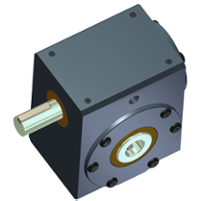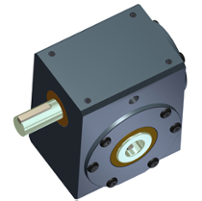

Worm gears are an ingenious way to turn motion into power, featuring a spiral-threaded shaft (akin to a screw) that turns and drives the meshing wheel gear. This type of setup is simple yet incredibly effective in turning momentum into usable energy. The screw and wheel meet at a 90-degree angle to form a right angle gearbox. Despite its simplicity, the worm gear can efficiently manage both power and torque in industrial applications. That allows:
- Control over rotational direction and speed
- Higher torque transmission
Worm gears are not necessarily the most efficient choice, but for certain industrial applications, they offer distinct advantages. The simplest example is the peg that turns to tune an acoustic guitar. This is the only type of worm gear that allows bi-directional turning. The worm gears used in industrial applications do not reverse, making them valuable to regulate speed and when braking and/or holding are required.
Right Angle Worm Gear Reduces Speed
The right angle worm gear is the most commonly used gear for reducing speed in industrial applications. It is durable, versatile, tolerant of shock loads and overloading, and cost-effective. The speed reduction ratio is determined by the number of threads in the worm shaft and the number of teeth in the gear. If needed, you can couple two gear reducers to improve speed reduction.
Worm Gears Can Be Used For Braking
Because they only rotate in one direction, worm gears can also be used as secondary braking devices.
For example, elevators and lifts often use worm gears to regulate load speed and prevent free-fall. Conveyor systems that use worm gears will lock up when stationary rather than running backward.
In applications where two-directional movement is required, two worm gears are used — one to manage each direction. This is a common setup for operating automatic gates, enhancing security because the gate cannot be breached or forced open.
Types of Worm Gears
There are three basic worm drive designs:
- Non-throated. Instead of a continuous thread, this style has a single moving point that contacts the gear. The minimal contact makes this type of worm drive most vulnerable to wear and tear from high unit load.
- Single-throated. This variation can withstand high unit loads with less wear. Its concave helix wraps around the worm, making continuous contact with the gear.
- Double-throated (called hourglass or cone). This style can withstand the highest unit loads without excessive wear and tear because it has concave teeth on both the worm and the gear, doubling the contact area.
Worm gears are ideal for low- to moderate-horsepower applications, where you need compact size but high ratios and high output torque, coupled with significant speed reduction. That can make them an ideal solution for conveyors, small machinery, and packaging equipment. They also operate quietly compared to other gear types, making them ideal for installations where noise would pose problems, such as elevators.. Additionally, since worm gears have fewer moving parts, there is less risk of failure.
Worm drives can be designed with right-hand or left-hand gearing, to turn either clockwise or counter-clockwise. With an internal helical gear, both parts must be the same hand. With external helical gears that function in parallel, the hands must be opposite.
Downloadable resource: Definitive Guide to Right Angle Gearboxes
Need Advice?
W.C. Branham is an industry leader in manufacturing right angle gearboxes. We offer three types of right angle (worm drive) gearboxes, and each model can be spec’d in numerous bore sizes and gear ratios. As simple as worm gears may be, determining which configuration would be best for your application may not be so simple. We are always here to answer your questions. If you need help, we encourage you to contact Branham's design and engineering experts.


